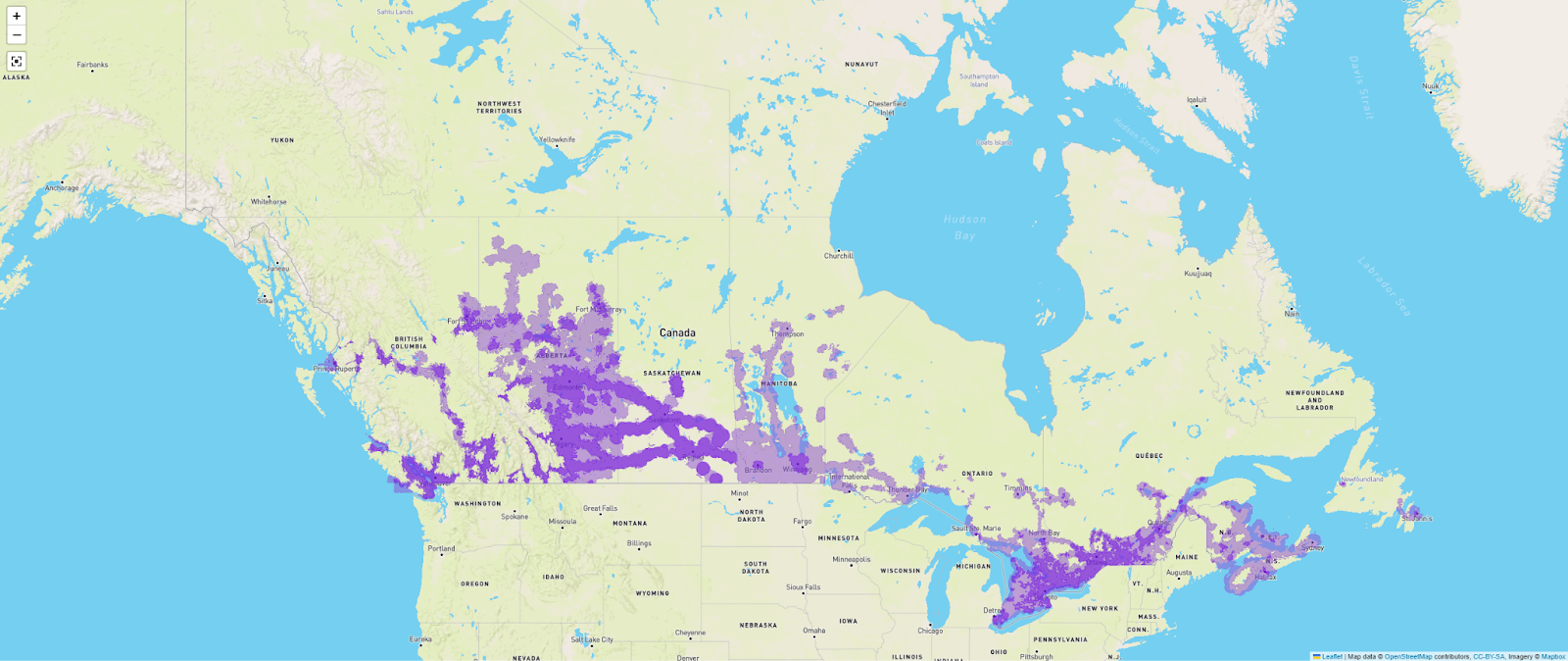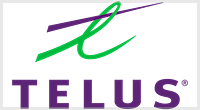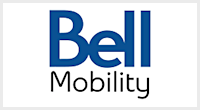
In this guide, we’ll break down everything you need to know about the Bell service map, including where to find 5G and how Bell’s network ranks against competitors like Telus, Rogers, and Freedom Mobile. In addition, we’ve got plans from Bell MVNOs to help you save on your monthly bill.
Bell coverage: Pros and Cons
What we love
- Large (and growing) 5G coverage
- 99% 4G LTE coverage
- Low-cost coverage through MVNOs and flankers
What could be improved
- 5G limited to metropolitan areas
- Limited options for rural areas
90/100
Bell 5G coverage map

The Bell service map reaches over 99% of Canadians, with 70% of the country receiving 5G speeds. The Bell network only covers 36% of the country’s land mass, though that’s not out of line with their competitors. Only Telus covers more ground than Bell, with a network footprint that spans 37% of the country. The reason for these geographically small networks is practical: The overwhelming majority of Canadians live near the country’s urban centres, so the Big Three have largely ignored the sparsely populated stretches of Canada’s northern wilderness.
Want to see if the Bell service map reaches your neck of the woods? Use the interactive map below to find your neighbourhood and see if Bell 5G or 4G LTE is available.
How good is Bell's 5G coverage near you?
Bell’s 5G network is the fastest mobile network in Canada, accessible to over 99% of the Canadian population, though coverage is mostly limited to urban centres in the southern half of the country.
Bell began offering 5G+, the fastest mobile technology ever, in 2022. The service provides users with high-speed connections, even in crowded areas like sports arenas and music venues. For now, Bell 5G+ is only available in select areas–including Vancouver, Calgary, Edmonton, Winnipeg, Toronto, and Montreal–but Bell continues to roll out the service in new areas.
Bell offers dozens of 5G cell phone plans, including
- The Ultimate 50GB Canada-US Plan, with 50GB of full-speed 5G data for $75/month, and
- The Ultimate 150GB Canada-US Plan, with 150GB of full-speed 5G data for $105/month.
How fast is Bell's 5G network?
Bell's 5G network is among the best in the country. The carrier operates a network that can reach theoretical speeds of up to 1.7Gbps. That said, however, it's more common that Canadians will find 5G speeds of around 500–700Mbps in many metropolitan cities.
Many factors can impact Bell's 5G network, including how many devices are connected. Densely populated areas are commonly impacted by network congestion. That said, Bell's 5G network can operate reliably even in high traffic areas and cities, so you'll find 5G connectivity even if you're attending a concert or walking through a populated mall or shopping center.
Bell 4G LTE coverage map
Is Bell's 4G LTE coverage available in your neighbourhood?
While supporting an extensive 5G network, Bell also offers LTE coverage from coast to coast in Canada. The company has operated the "largest 4G network" in Canada for many years. Unlike its 5G coverage, Bell's 4G LTE network is accessible in more rural areas. So, unless you live in a well-populated metro city or town, you'll likely be on the LTE network.
Here's a look at Bell's LTE coverage map. As you can see, much of the LTE coverage spans Southern Ontario, Saskatchewan and Alberta. More populated regions across BC, Quebec, and Nova Scotia also have wide-ranging access to LTE services.
How fast is Bell's 4G LTE network?
Bell customers on the 4G LTE network won't have the benefits of 5G connectivity. Instead, you'll find average download speeds of around 50–200Mbps. This is enough to scroll social media, answer emails, and do some browsing while off of Wi-Fi. Across Canada, Bell offers both standard LTE and LTE Advanced, offering minor differences in speeds and capacity.
Bell coverage vs. Telus, Rogers, and Freedom Mobile
You’ve seen the Bell coverage map, but how does it compare to the competition? Let’s take a look at how it stacks up against the other major wireless networks in Canada: Telus, Rogers, and Freedom Mobile.
Network coverage in Canada
| Carrier | 5G coverage | 4G LTE coverage | Total network coverage |
|---|---|---|---|
| Telus | 70% | 99% | 99% |
| Bell | 70% | 99% | 97% |
| Rogers | 70% | 97% | 99% |
| Freedom | 31% | 99% | 99% |
Bell vs. Telus coverage
Telus has the largest network in Canada, with its 4G LTE service reaching over 99% of residents. Telus and Bell share cell towers, allowing the carriers to build the biggest wireless networks in Canada while maintaining independent companies. Telus’ network covers 37% of the country’s land mass, making its network slightly bigger than Bell’s. That’s most evident in the north: The Telus network is in rural stretches of Canada–like the Yukon, Northwest Territories, and Nunavut–where Bell’s coverage is minimal.
Telus’ 5G service mostly matches Bell’s, with coverage primarily limited to metropolitan areas and, like Bell, its 5G service reaches 70% of the population. Unlike Bell, however, Telus does not currently offer 5G+ service.
Want to see if Telus coverage is available near you? Use the interactive coverage map below.
Bell vs. Rogers coverage

The Rogers network is smaller than Bell’s in both land mass and reach, covering 28% of the map and 97% of the population. There are pockets of the Yukon and Northwest Territories where you can receive Rogers’ Extended Coverage if you’re travelling, though the carrier emphasizes that Extended Coverage is only for “limited and occasional use.”
Rogers was the first carrier to launch a consumer 5G network in Canada and now, like Bell and Telus, offers service to 70% of Canadians. The carrier also continues to expand high-speed wireless service throughout the country, including 5G+ in British Columbia, Alberta, Manitoba, Ontario, and Quebec.
If you want to get a better sense of what service Rogers offers near you, check out the interactive map below.
Bell vs. Freedom Mobile coverage

Freedom Mobile’s network is growing to be comparable to Bell’s. Freedom began offering 5G coverage thanks to its partnership with Videotron a few years ago. Service now covers 99% of the Canadian population, with the network expanding continuously.
Freedom Mobile’s 5G and 4G LTE networks are almost exclusively limited to major metropolitan areas, though they do offer coverage outside of the Freedom Network through partner networks. Buyer beware, though: These partner-powered connections are throttled, meaning you’ll experience speeds closer to 3G.
Want to see if Freedom Mobile’s 5G or 4G LTE service is available near you? Take a look at our interactive coverage map below.
Bell's network availability and reliability
Umlaut, a telecom research company, named Rogers the most reliable wireless network in Canada. The total possible score was 600: Rogers earned 547, Bell earned 526, and Telus rounded things out with 510. With that being said, Bell received favourable ratings for its network’s low latency and high stability, so customers can expect reliable coverage across the Bell network, even if it ranks below Rogers.
Check Bell coverage in your area
If you’re looking to see how reliable Bell’s network is near you, you can find that in one of our geographic guides below.
- British Columbia Wireless Coverage
- Alberta Wireless Coverage
- Saskatchewan Wireless Coverage
- Manitoba Wireless Coverage
- Ontario Wireless Coverage
- Quebec Wireless Coverage
- New Brunswick Wireless Coverage
- Nova Scotia Wireless Coverage
- Prince Edward Island Wireless Coverage
- Newfoundland and Labrador Wireless Coverage
Cell phone coverage by city:
- Vancouver Cell Phone Coverage
- Edmonton Cell Phone Coverage
- Calgary Cell Phone Coverage
- Toronto Cell Phone Coverage
- Ottawa Cell Phone Coverage
- Montreal Cell Phone Coverage
- Quebec City Cell Phone Coverage
Best phone plans on Bell's network
If you're looking to migrate to Bell or find a brand new phone plan for you or your family, Bell offers a range of plans to fit your needs and budget. While the carrier is on the more expensive side of major Canadian providers, you'll find an assortment of plans offering various data buckets and unlimited Canada-wide talk and text.
MVNOs, short for Mobile Virtual Network Operators, offer customers affordable access to large wireless networks. Bell owns and operates three MVNOs on its nationwide network, including flankers Virgin Plus and Lucky Mobile and the prepaid carrier PC Mobile. If you’re looking for the reliability of the Bell network but want more affordable monthly payments, a Bell MVNO is a great option.
If you’re in an area with solid coverage already, why not save on your monthly costs and get access to comparable services in many cases?
You can find the most popular plans from Bell MVNOs below.
FAQs
Related Articles
Find Better Phones and Plans
Hundreds of cell phone plans unpacked. All the facts. No surprises.






































